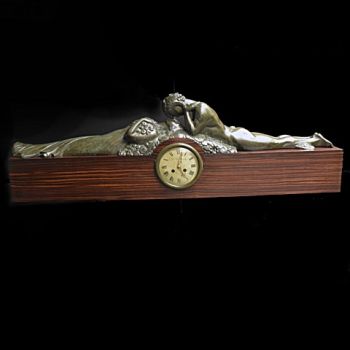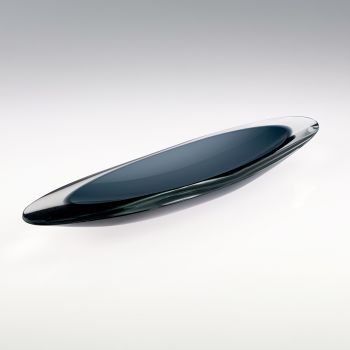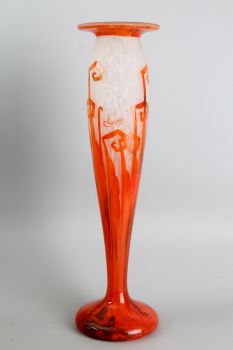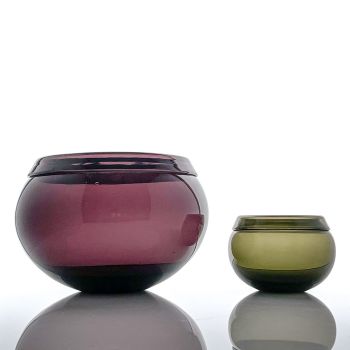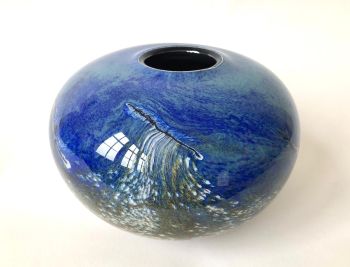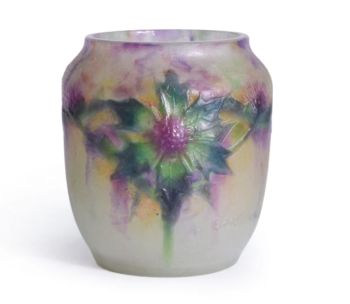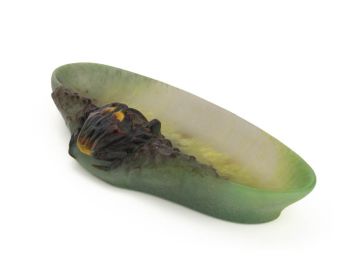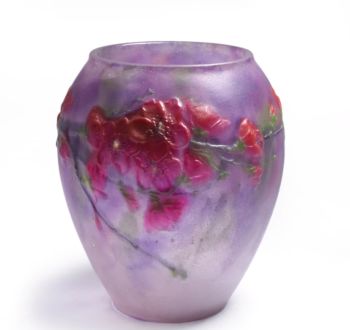Johann Loetz Witwe – “Zebra” decor, designed by Koloman Moser for E. Bakalowits – 1903 1903
Johann Loetz (Lötz) Witwe Klostermühle
Glas
8 cm, ø 7 cm
ConditionMint
Preis auf Anfrage
Antiques Emporium
- Über KunstwerkIntroducing a rare and captivating piece by Johann Loetz Witwe, featuring the exceptionally rare Zebra decor, designed by the renowned Koloman Moser in 1903 for E. Bakalowits, Vienna. This exquisite vase/cup is a true testament to the artistic brilliance and innovative craftsmanship of the early 20th century.
The Zebra decor is a distinctive and highly sought-after pattern, characterized by its striking black and white or contrasting dark and light bands that mimic the natural beauty of zebra stripes. The intricate glasswork and iridescent finish highlight the exceptional skill and artistry of Loetz glassmakers.
Koloman Moser, a pivotal figure in the Vienna Secession movement, designed the Zebra decor in 1903. Moser was instrumental in shaping modern design, blending artistic creativity with functional elegance. His work in 1903 was marked by groundbreaking designs that pushed the boundaries of traditional decorative arts.
This vase/cup is not just a decorative item but a piece of history. In 1903, Moser’s designs were revolutionizing interiors, moving towards modern, geometric styles that emphasized simplicity and elegance. His collaboration with Loetz and E. Bakalowits resulted in pieces that were both artistic and commercially successful, appealing to the discerning tastes of the time.
Koloman Moser (1868-1918) was one of the foremost designers of the Vienna Secession, a movement that sought to break away from the historical emphasis on traditional styles. In 1903, Moser was at the height of his career, creating innovative designs that were both functional and aesthetically pleasing. His work during this period included not only glassware but also furniture, textiles, and entire interior designs, showcasing his versatile talent and visionary approach.
This vase/cup, with its Zebra decor, is an excellent addition to any modern interior. Its bold pattern and elegant form make it a striking centerpiece, whether displayed on its own or as part of a collection. The piece reflects the transition towards modern design principles that Moser championed, making it both a timeless and contemporary artifact.
Dimensions:
Height: 88mm / 3.46”
Diameter top: 75mm / 2.95”
Diameter base: 65mm / 2.56″
Condition: Mint
Literature:
Hatje Cantz – Loetz Bohemian Glass 1880 – 1940 – Page 159, 160 & 316.
Prestel – Böhmisch Glas 1880 – 1940 Band 1 Werkmonographie – Page 172, 173, 178 & 340 . - Über Künstler
Etwas mehr als hundert Jahre existierte die Glashütte Lötz in Klostermühle, Österreich, ab 1840. Ihre Blütezeit erlebte sie jedoch zu Lebzeiten von Max Ritter von Spaun, dem Enkel des ursprünglichen Gründers Johann Lötz.
Von Spaun übernahm 1879 das Unternehmen und führte es bis 1908, ein Jahr vor seinem Tod. Er wurde von seinem technischen Spezialisten Eduard Prochaska unterstützt, und gemeinsam erfanden, entwarfen und produzierten sie eine ganze Reihe wunderbarer neuer Glasarten, erwarben mehrere Patente und gewannen Preise auf allen großen Weltausstellungen in den 1890er Jahren und in den ersten Jahren des 19. das neue Jahrhundert.
Die Firma Loetz gehörte zu den Vorreitern im Jugendstildesign und insbesondere im Bereich des schillernden Kunstglases. "Papillon"-Glas, wie die Vase links, wird heute manchmal als "Ölfleck"-Glas bezeichnet. Eine weitere beliebte Farbe von Loetz war bestrahltes Glas mit gezogenen Spuren, das als "Phenomenon" -Glas bezeichnet wird.
Es gab irritierte Vasen mit Bändern in Metallic-Farben, die sich über die Oberfläche schlängelten, und viele spektakuläre Designs mit applizierten Pfaden in schönen Farben oder einfach aus dem Glaskörper herausgezogen, um Griffe oder Dekorationen zu bilden.
Um 1900 begann das Unternehmen mit externen Designern zusammenzuarbeiten, und einige große Künstler entwarfen Stücke für Lotz, insbesondere Joseph Hofmann, Koloman Moser, Maria Kirchner und Hofstatter.
1908 wurde Loetz von Max von Spauns Sohn, auch Max genannt, übernommen, und obwohl es finanziell zu kämpfen hatte (Konkurs 1911 und erneut 1931), gab es mehrere große Designer, deren Arbeiten in diesen Jahren und durch die Kunst von Loetz produziert wurden Deko-Zeit. Dazu gehörten Adolf Beckert und Michael Powolny.
Sind Sie daran interessiert, dieses Kunstwerk zu kaufen?
Artwork details
Related artworks
Johann Loetz (Lötz) Witwe Klostermühle
Johann Loetz Witwe - Phänomen Genre 7773 – Orange1900 - 1910
Price on requestAntiques Emporium
Johann Loetz (Lötz) Witwe Klostermühle
Johann Loetz Witwe – Jugendstil Cobalt Papillon vaas1900 - 1910
Price on requestAntiques Emporium
1 - 4 / 7René Lalique
An early vase 'Bluets' designed by Rene Lalique (1860-1945)1910 - 1920
Price on requestLennart Booij Fine Art and Rare Items
1 - 4 / 24Gabriel Argy-Rousseau
Gabriël Argy-Rousseau – Crabes et Algues vase – 19201920 - 1929
Price on requestAntiques Emporium
Frères Daum
Daum Nancy – “Paysage Soleil Couchant” vase with two applied handles1900 - 1910
Price on requestAntiques Emporium
Johann Loetz (Lötz) Witwe Klostermühle
Johann Loetz Witwe - Phänomen Genre 7773 – Orange1900 - 1910
Price on requestAntiques Emporium
1 - 4 / 24Johann Loetz (Lötz) Witwe Klostermühle
Johann Loetz Witwe – Jugendstil Cobalt Papillon vaas1900 - 1910
Price on requestAntiques Emporium
1 - 4 / 24Amalric Walter
Amalric Walter & Henri Bergé – Crabe plumier1920 - 1929
Price on requestAntiques Emporium
1 - 4 / 24Gabriel Argy-Rousseau
Gabriël Argy-Rousseau – Crabes et Algues vase – 19201920 - 1929
Price on requestAntiques Emporium
Frères Daum
Daum Nancy – “Paysage Soleil Couchant” vase with two applied handles1900 - 1910
Price on requestAntiques Emporium
Amalric Walter
Amalric Walter & Henri Bergé – Crabe plumier1920 - 1929
Price on requestAntiques Emporium
Unknown artist
François-Théodore Legras – Tall “Fleurs de Pommier” apple blossoms vase1900 - 1909
Price on requestAntiques Emporium
1 - 4 / 12






























